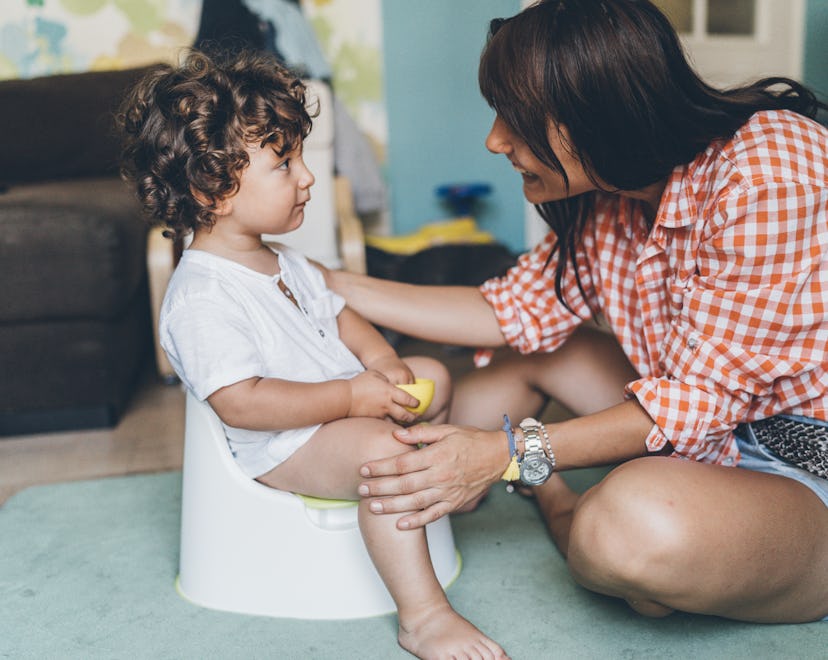Potty Training

How Often Should A Toddler Pee When Potty Training? It Depends
Every child is different.
I don't know about you, but I'm personally super pumped for that perfect day in the admittedly far-off future when I throw that last diaper away — and then throw myself a party. If you're currently in the midst of toilet training, I salute you, and I also know you have a lot of questions. Whether it's going well or not, wondering things as simple as, "How often do toddlers pee?" is all part of the process. Here’s what the experts want you to know.
How often should a toddler pee?
As you might have guessed, there is no one correct answer for how often a toddler should pee when potty training. How frequently a toddler goes to the bathroom is completely dependent on the child, according to certified potty training consultant Abby Klein. “Some children will go as little as two times per day; some will go every one to two hours,” Klein says. “As long as your child is not uncomfortable, do not stress about the frequency they are going.”
Toilet training can be one of the most difficult milestones for children and their parents, and it can become highly emotional. Self-esteem can be fragile during this time, so it's important to toilet train gently, letting your child lead the way. Additionally, it's unwise to begin potty training unless your child is truly ready. “Most kids should be able to hold their pee for two to three hours,” Anneliese Schlachter, a certified potty training consultant, tells Romper. “That can fluctuate in the beginning learning stage, or depending on their fluid intake. After the first two weeks, parents should be able to better recognize their child's patterns.”
When to take your toddler to the potty
In terms of actually getting your toddler to the potty, there are different strategies. While some people think its best to nudge your toddler to the potty every so often once the diaper is off, the experts say it’s actually best to let your little one lead the way, rather than the other way around. “I recommend minimal prompting [and] not doing timed sits,” Schlachter says. “Allowing your child to have accidents and learn how to understand their body's signals is helpful for them to become more independent with going to the potty.”
Klein also recommends avoiding prompting, unless it's really needed. “If it is obvious your child needs to go, then bring awareness to them, for example: ‘It looks like your body is telling you that you need to pee. The potty is right over there when you're ready,’” Klein says. “This is one area your child has complete control over. We cannot ‘make them go.’ Prompting, especially over-prompting, tends to backfire on parents. I see a lot of resistance in children when prompted or over-prompted simply because they do not need to go. As a parent, this can be a challenging, but ultimately, we want them to learn to listen to their body and make the decision to use the potty.”
Whether or not you decide to establish a potty routine is child dependent, and most don’t typically need one. “When it comes to going potty, there will be less resistance when we let the child decide when they need to go,” Schlachter says. “However, some kids do well with a routine, and may do better with one depending on if they are already familiar with more structure at day care [or] school.”
Answers to the questions that keep you up and night — and stories you want to share with the group chat.
That being said, keeping rough markers for major parts of the day can be helpful guidelines. “Mornings, before and after nap, and before bedtime are the only points in the day I would try to incorporate using the potty into their daily routine,” Klein says. “There is a small portion of children that I recommend toileting schedules for, but they are few and far between.”
Of course, you can adapt this routine to your lifestyle, and you still must be on the lookout for signs your toddler has to go ahead of schedule, or just simply doesn’t have to go. If they look squirmy, take them to the potty. But if you miss the signal and there's a mess, it's also no big deal. Practice makes perfect, after all.
And finally, remember that it's OK if they need a day off or have setbacks along the way. “Toileting is a learned skill — it's no different than a child learning to eat, learning to walk, or learning to talk,” Klein says. “Every child will learn at their own pace, so do not throw in the towel too early when training! I always like to give things at least two weeks before considering a reset. For some children, things may ‘click’ on day three, for others it may be day eight or later. Accidents are bound to happen as they are mastering this skill. This may lead to moments of frustration, but try to stay in a positive space with it all. Consistency is key!”
The bottom line: When it comes to potty time, there's no magic number. If it helps, follow a rough schedule — morning pee, before nap time pee, bedtime pee — and remember to look for signs that they're holding it. And if negative emotions start attach themselves to toilet time, it's OK to take a break. It might take some time to achieve that no-more-diapers party, but that's fine. You'll just have that much longer to plan a good one.
Experts:
Anneliese Schlachter, certified potty training consultant
Abby Klein, certified potty training consultant
This article was originally published on